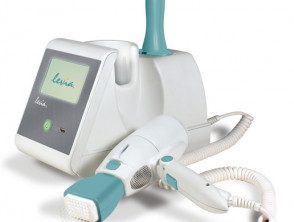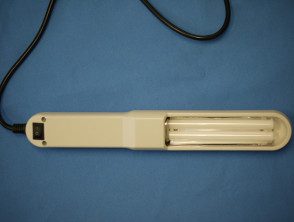What is home phototherapy?
Phototherapy is the use of light or other forms of non-ionizing electromagnetic radiation in treatment. Light or radiation is produced by a medical device commonly called a phototherapy unit.
The most widely used medical lamps in phototherapy units emit a narrow band of ultraviolet light (UV) radiation, which reduces or eliminates various skin diseases, at least temporarily.
Home phototherapy is a relatively safe and effective non-pharmacological option for self-treatment of skin disorders in the privacy and comfort of the patient's home. Phototherapy should be controlled and supervised by an experienced doctor. However, not all dermatologists agree to monitor phototherapy at home due to the possibility of Adverse reactions.
The treatment can be administered to the skin of the entire body or can be precisely targeted to the affected areas to minimize exposure of unaffected skin.
Home phototherapy

Levia Driven System

Chinese unregulated narrowband UVB device
Indications for home phototherapy.
Skin conditions treated with home phototherapy may include:
- Psoriasis
- Atopic dermatitis/ /eczema
- Seborrheic dermatitis
- Vitiligo
Home therapy is not suitable for all patients with these skin conditions, and results vary.
Home phototherapy devices
Home phototherapy units range from handheld and benchtop devices for localized treatment of small areas of affected skin to “walk-in” cabinets or units for patients requiring full body treatment.
Known companies that provide home phototherapy units include Daavlin, UVABiotek (Hudson Falls, NY, USA), Solarc Systems Inc (Ontario, Canada), and National Body Corp (Ohio, USA). These companies offer full panel and single panel wrapping systems in addition to hand / foot units.
Unregulated home phototherapy devices are also marketed online. Your safety and effectiveness are unknown
Benefits of home phototherapy.
- Home equipment delivers the dose to the patient and prevents unauthorized use.
- Incorporates medical software control dosimetry.
- Precise targeting minimizes exposure of non-involved skin areas and facilitates rapid and controlled treatment.
- It is profitable
- It has narrowband UVB, broadband UVB and UVA radiation options.
- High-performance lamps shorten treatment times.
- Easy to operate patient interface.
- It accommodates patients of any body type, color or skin size.
- Eliminate long trips to the phototherapy clinic.
- Makes it easier to maintain a treatment program - fewer missed visits and better results.
- It allows patients to go directly from the shower or bath to the lights. This improves the effectiveness of the treatment.
- In the United States, the purchase of devices is covered by many health insurance plans.
How often are the treatments taken?
Psoriasis
Initially, treatments to clean license plate Psoriasis is taken 3-5 times a week. Your doctor may recommend stopping treatment once the psoriasis is clear. Some patients will continue treatment less frequently during a maintenance regimen.
Vitiligo
Vitiligo treatments are usually taken twice a week, never on consecutive days due to the risk of burning white skin. Treatment times are usually short.
Other skin conditions.
Eczema and other less common skin conditions require medical guidance for the times and duration of treatment.
How long does it take to get results?
This depends on the condition of the skin.
In psoriasis, improvement is evident after approximately 10 treatments and it is rare to require more than 20-30 treatments to cleanse the skin. When psoriasis recurs, your doctor may recommend another course of phototherapy. Phototherapy can be combined with current and systemic medications if necessary
In vitiligo, effectiveness is evaluated after 16 weeks or at least 30 treatments. If repigmentation is observed, it can be continued for many months, but should be discontinued if progress slows.
Is a doctor's approval necessary for a home light therapy unit?
Like any other FDA-regulated drug or procedure, US regulations state that phototherapy systems used to treat psoriasis, eczema, vitiligo, or other light-sensitive conditions cannot be sold to anyone. without a valid prescription from a doctor.
Home phototherapy safety.
Home phototherapy is potentially dangerous, as UV radiation damages the skin and can cause severe burns (such as sunburn). Excessive exposure to UV radiation can also lead to long-term aging and skin aging. Cancer even melanoma, scaly cell carcinoma (SCC) and basal cell carcinoma (BCC).
It is more likely to burn in light-skinned people with Fitzpatrick skin type 1 and 2 compared to darker-skinned people with Fitzpatrick skin type 4, 5 or 6. It is also more likely to burn in people taking certain photosensitizing medications, including antibiotics and antiinflammatory Medications Tell your doctor the names of all your prescription medications and on the counter medications before starting treatment, and check with your doctor if you start a new medication while undergoing home phototherapy.
Home therapy can be safe if the dosage is carefully controlled. Side effects reported by one study included red skin (erythema, at 36%), blisters (1%), itching (8%) and dryness (1%).
Safety features in the new home phototherapy units include:
- A keyed on / off switch to prevent unauthorized use
- a built-in controlled prescription timer (CPT) that ensures that the equipment can only be used for a certain number of treatments as prescribed by the doctor between office visits
- A safety feature that disables the unit in the event of a malfunction.
Such innovations make home phototherapy a suitable option for many patients. Response to treatment and adverse events must be carefully monitored by your doctor.

